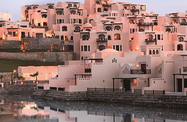As part of a long-term strategy to diversify the economy by capitalising on the emirate’s natural beauty, Ras Al Khaimah (RAK) is moving forward with ambitious plans to rebrand itself as a tourism destination.
By 2021, RAK expects around 20% of its GDP will be generated by tourism-related activities, which even by 2011 figures would mean the industry would be generating in excess of $1bn per year, an excellent return on investments currently under way.
To achieve this, RAK is aiming to increase arrival numbers to 1.2m by 2013, while boosting accommodation availability from the current 2700 rooms offered by the emirate’s 14 four- and five-star facilities to around 10,000 rooms by 2016. This drive is led by the RAK Tourism Investment and Development Authority (TIDA), established in mid-2011. According to Victor Louis, the authority’s chief operating officer, tourism will become a pillar of RAK’s developing economy.
“We are almost doubling the inventory levels of the total hotel rooms in RAK in the coming 16 months,” Louis told OBG. “In order to move parallel with this growth, we have identified key segments that will aid in the facilitation of boosting the emirate’s tourism attractions. The government has assigned to RAK TIDA Dh800m ($217.79m) to develop and increase the number of tourism projects in the emirate.”
TIDA has set a target of 800,000 visitors for 2012, while also planning to increase room numbers by at least 20% this year. The expansion should be achieved with the opening of two high-end facilities – the 349-room Waldorf Astoria and the 630-room Bab Al Bahr – scheduled for October, in time for the 2012-13 winter season. Those additions will be joined by the 309-room DoubleTree Resort by Hilton, scheduled to open in 2014 on Marjan Island, the emirate’s offshore tourism project.
The extra accommodation will likely be needed: in late 2011, TIDA inked a series of agreements with European tour operators to bring visitors to RAK in 2012 and beyond. Deals with Swedish operator Apollo and German firm Reise Service Deutschland will see more than half a dozen charter flights a week arriving at RAK Airport from northern European destinations, with seat numbers totalling 55,000.
“To further attract tourists, we cannot solely depend on Dubai’s International Airport and major carriers as our main source for bringing tourists to our emirate,” Louis told OBG. “Therefore, we are in the process of setting up a charter operation company with fixed aircrafts on ground prepared for back-to back flights as seen in major tourist destinations around the world. This will encourage tourist operators to charter flights directly once a week on rotation from season to season from targeted countries.”
While tourism officials are upbeat about industry prospects, there could be some bumps on the road towards achieving these goals. The emirate’s tourism industry may be affected by several factors in the coming year, not the least of which is recession in some key markets and stiff competition.
Recent trends in the eurozone economy, with many member states teetering on the brink of negative growth or having already fallen over the edge, may mean the flow of European visitors will slacken 2012, despite the increase in charter flights. Another challenge will be maintaining differentiation from neighbouring countries with similar offerings. However, even if the coming year does not live up to expectations, 2012 will give RAK the opportunity to put in place more holiday infrastructure and accommodation, meaning it should be well placed to take advantage of any post-downturn boom.
Much of this work will be done at trade fairs across Europe, RAK’s key market. Having already taken part in the World Travel Market in London in November, TIDA is planning a two-week road show to leading outbound markets in Europe, a move designed to heighten awareness of RAK as a winter destination.
With many development projects well on track, RAK should have little trouble providing the hotel and hospitality facilities needed to handle an increased flow of overseas visitors. As long as its client markets remain healthy and the emirate is able to maintain momentum in raising its profile, RAK should be able to carve out a sizeable niche in the region’s tourism trade.

